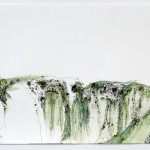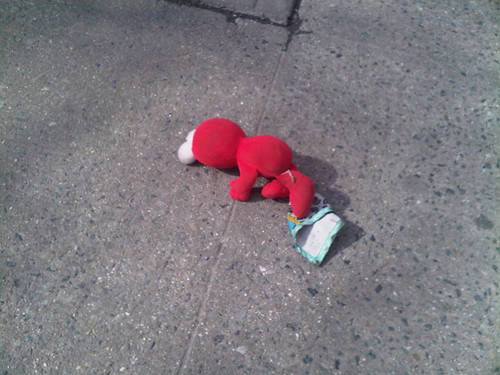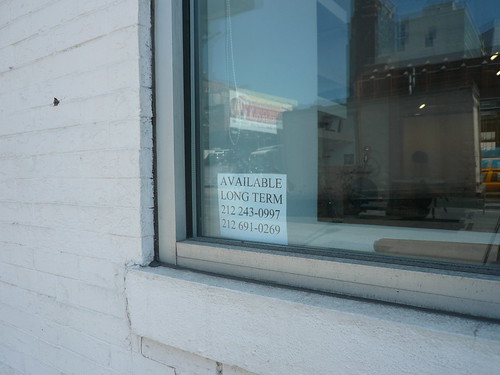Category Archives: ARTspace
A Few Minutes with Claudia Sbrissa
- Claudia Sbrissa. Wayward, 2010, Velvet Flocking, pen, ink. 44” x 33”. From the series Satis House. Photo courtesy the artist.
- Claudia Sbrissa. Memory: Landscape, 2010. Flocking, pen, ink, watercolor. 17” x 28”. From the series Satis House. Photo courtesy the artist.
I will echo the sentiments of my fellow bloggers—the Annual Conference provides innumerable ways to catch up with friends, in unlikely ways. After catching the Health and Safety in the Studio session in ARTspace, I was able to sit down very briefly with Claudia Sbrissa for a chat. I invited Claudia on a panel I chaired in 2009 in Los Angeles, entitled “Ornament Now: Reassessing its Theories and Functions,” but have not seen her since. Thank goodness for Facebook!
After getting caught up with our personal lives since 2009, we got down to professional activities! Claudia was busy recently working on a new series. She notes, “The series Satis House continues my engagement with notions of place and space. The work explores processes of transformation; the simultaneous perishing and reinventing of our narrative; our collective loss, desire and longing.”
Claudia continues, “My process involves shredding black velvet into flocking, which I use as a drawing material. The abstract forms and shapes though mysterious are rooted in the natural world, alluding to organisms and the body in flux; a world overwhelmed, dissolving, and mutating. I work back into these spaces using pen, ink and watercolor to create dense clusters and masses. These spaces move from microscopic to macroscopic, suggesting illusions of infinite depth and space. Somewhere within these fragmented worlds lies our future; the promise of renewal.”
Currently teaching at St. John’s University, New York, Claudia received a BFA from York University, Toronto, Canada, a Bachelor’s in Education from Queen’s University, Kingston, Canada, and an MFA from Cornell University, Ithaca, NY. Recent exhibitions and projects include: this place is a bunch of lines Salon, Salon Ciel, New York, NY (2010), a site specific installation & works on paper, The Muriel Guepin Gallery, NY, NY 2010, The Persistent Future, Cue Foundation, New York, NY 2010, Utopia is Hard, Courthouse Gallery, Lake George Art Project, Lake George, NY 2009, Uncommon Threads, Walsh Gallery, Seton Hall University, NJ 2009, Exquisite Corpse, curated by Anonda Bell & Caren King, Paul Robeson Galleries, Rutgers University, New Brunswick, NJ, 2009. Awards include residencies at Woman’s Studio Workshop, Rosendale, NY, Contemporary Artist Center, North Adams, MA; I-Park in East Haddam, CT; Lower Eastside Printshop, NYC; and Skowhegan School of Painting & Sculpture, Skowhegan, ME; as well as grants from Queen’s Council on the Arts, and The Canada Council on the Arts.
Green that Studio!
ARTspace
CAA Services to Artists Committee
Health and Safety in the Artist Studio
Wednesday, February 9th
Chairs: Mark Gottsegen, AMIEN and ICA Art Conservation; and Brian Bishop, Framington State University
Panelists: Jennifer Steensma Hoag, Calvin College
Brian Gillis, University of Oregon
Claudia Sbrissa, St. John’s University
David Zenk, Gund Partnership; and Monona Rossol, Arts, Crafts, and Theater Safety, Inc.
Mark Gottsegen, AMIEN, and ICA Art Conservation
At the 2008 CAA conference in Dallas, I co-chaired for the Professional Practices Committee, with Duane Slick of the Services to Artists Committee, a session entitled “The Sustainable Studio.” That session, also held in ARTspace, consisted of Duane speaking to his experience upgrading the RISD painting studios. As the art historian on the panel, I presented a paper entitled “Hazardous Traditions: A Short History of the Environmental Impact of Art Practice,” tracing the origins and historical usage of traditionally toxic materials in art practice. We also invited the artist Jae-Rhim Lee of MIT, whose studio work focused specifically on bio-remediation, to posit a potential answer to the use of toxic materials in the studio. Since then, there has been an explosion in the interest in “greening” the studio, and practice. So it was with great curiosity, and pleasure, that I attended this year’s Services to Artists Committee and ARTspace session “Health and Safety in the Artist Studio.”
This particular session, in comparison to the 2008 session, provided specifically ideas, information, and even where to start, if one has been bestowed with the arduous task by their department to create an environmentally safer, OSHA-compliant, accreditation-accommodating, and pedagogically advantageous studio. The nuts-and-bolts nature and breadth of these presentations made them easy to understand, and they covered a wide variety of disciplines.
Jennifer Steensma Hoag and Brian Gillis addressed the explicit needs of the specialized photography and ceramics studios. Jennifer went into detail about the different high tech collection systems Calvin College is utilizing to process developing chemicals. Brian provided in depth information about the leading occupational lung disease known to ceramists, Silicosis. Information regarding shop hazards, and common health and safety issues in a ceramics studio was also discussed.
David Zenk and Monona Rossol, and Mark Gottsegen addressed more general building design parameters, such as building codes, energy conservation, chemical storage and use, the storage and disposal of hazardous waste. Mark showed several examples of good and bad examples of proper ventilation and storage. The information provided was vast, and extremely illuminating. In particular, Mark Gottsegen reminded all of us that studios are also, technically, chemical labs and industrial machine shops, and should be treated accordingly. Secondly, he reminded us to “READ THE LABELS!”
Claudia Sbrissa brought a unique and equally significant point of view to the discussion. In her paper “Greening the Studio,” Claudia discussed the convergence of receiving the commission in 2003 to renovate the printmaking studio at St. John’s University in New York, a studio not modernized since the 1970s, and the necessity to make massive changes to her own artistic and personal life, to make them “greener.” During the course of the panel discussion, dialogue veered toward the attitudes, and/or willingness, of the faculty and students to maintain this “green” sensibility. Again, Claudia experience best provided for this answer. She made it very clear that, if you continually practice “green art,” your students will take note, and follow suit. She mentioned, and I agree, that most students today are very aware of, and passionate about, environmental issues, they just need to learn the detailed training in studio management, and the encouragement from faculty to integrate these practices into their professional and personal lives.
Brian Gillis offered a brief overview for putting together a proposal for studio upgrades. In other words, for asking for what you need:
• A needs assessment/report
• Proposal
• Meet with Department Head
• Meet with Safety Officer
• Meet with Dean
• Try to connect with diverse funding sources on and off campus
• Because of budget issues, try as much as possible to connect funding with best practices.
In response to funding, here are key areas to look at:
• Training
• Policies/Protocols
• Curriculum
• Facilities
• Equipment
I remember creating in studios caked with paint, resins, and inks. Students and faculty alike repeatedly ate, drank, and even smoked inside the studios, alongside the pigments and mineral spirits. Ventilation was at a minimum. Thanks to Brian Bishop and Mark Gottsegen, and everyone on this panel, as well as previous panels, for highlighting such an important issue!
Making a Living as an Artist (With or Without a Dealer) – part 2
Image Via
Continued from Part 1, posted on Thursday, Feb 10, 2011: “Making a Living as an Artist: With or Without a Dealer,” was organized and chaired by artist Sharon Louden, with the artist and writer Sharon Butler, artist, former gallery director, curator and current Director of the Elizabeth Foundation for the Arts Studio Program Bill Carroll; artist, curator and current Dean of The New York Academy of Art Peter Drake; and New York dealer, blogger and author of How to Start and Run a Commercial Art Gallery Ed Winkleman.
Sharon Louden: Once you’ve done your homework and figured out which galleries are appropriate for your work, how do you get their attention? Is it just about the work?
Ed Winkleman: Yes, it’s just about the work. Believe it or not. The best way to approach a gallery is through one of their artists, or through curators associated with that gallery. But it’s not just about finding the gallery that’s right for you, because the galleries also have to think in terms of balancing their programs.
Bill Carroll: Actually, it wasn’t just about the work. I wanted to know whether younger artists were real go-getters. Also, whether an older artist has a great reputation. And [things that matter]: teamwork, personalities, sharing strategies, collector lists, etc.
Sharon Butler: You need to get the gallery to notice you, not by sending them your work, but by creating a SCENE. By making your voice heard. Any effort you put into building the community will be rewarded. So: rather than trying to bust into someone else’s scene, make your own.
Peter Drake: Put yourself in the galleries’ shoes, behave professionally. Don’t send out “shot-gun” packages. It’s insulting. Do the research.
Sharon L: How do I do all these things? It’s too much! Teaching/working/self-promoting/developing community/working with my dealer: this is all under the umbrella of being an artist.
Sharon B: The key to having an active, creative life is to connect the things you want to do. Find the things you want to do, and do them.
Bill: I’m REALLY social — running a gallery was really about connecting the artists to the world. …Find ways to integrate the various creative things you do — it’s part of the deal.
Ed: Artists today have a HUGE advantage over previous generations because they can do much of these things at home, online, in their pajamas. … Regarding the idea of ‘artistic purity’ — being in your studio all the time — having a conversation about your art, that too is something artists really want, and it requires social skills.
Peter: Diversify what you do creatively. Any time your life changes, it will change your studio practice. You will need to adjust. Think of socially engaged models such as Hallwalls…
Image Via
Sharon L: I’m going to talk about New York. Is New York City IT? What is your opinion about that?? And if you want a gallery in NY but live out of town, how do you do that? How do NY galleries deal with, or do they work with artists from out of town?
Ed: We work with two artists who actually live in Bishkek, Kyrgyzstan (laughter). The art world is decentralizing more and more. New York is not what it was just a few years ago. Take, for example, the VIP Art Fair — it was entirely online. 139 of some of the world’s major galleries participated. We connected with collectors in Italy and elsewhere. We normally wouldn’t have. In terms of the art marketplace, this change is coming like a tidal wave.
Bill: Okay, but Chelsea has over 300 galleries — where else can you find that? Soho at its height had only ~150 galleries. Artists must connect and make a name for themselves in their own locales and territory. If you do that, ultimately some New York gallery WILL want to show you.
Sharon B: I want to go back to on of Ed’s earlier comments about having a gallery’s artist refer you: you NEED to work with the community around you. Create an exchange, make connections with artist communities in other cities and towns, rather than badger galleries.
Peter: If you’re going to be part of a global community you have to be proactive.
Ed: I’m with Bill on loving NYC — but if you look at some of the larger galleries, they are opening up spaces in other cities. Don’t put all your eggs in one basket.
Sharon Louden: What does “representation” mean these days?
Bill: When the art world was smaller, the relationships were much more personal. There were stipends. Dealers like Betty Parsons were situated somewhere between collectors and dealers [like patrons]. This is long over. As is the idea of a ‘life-long’ relationship.
Sharon L: That goes back to the idea of ‘parents’.
Ed: The stipend was an act of faith… also, there are so many galleries now, and so many of them run on a shoe-string budget. Forty or fifty years ago, this wasn’t the case. We have different models now.
Sharon L: What should the expectations be between artists and dealers?
Ed: That is a conversation you must have before you enter into the relationship. It’s really a case-by-case thing, depending on the artist an what kind of career they have.
Sabina Ott Talks Media Lounge & “Band of Outsiders”
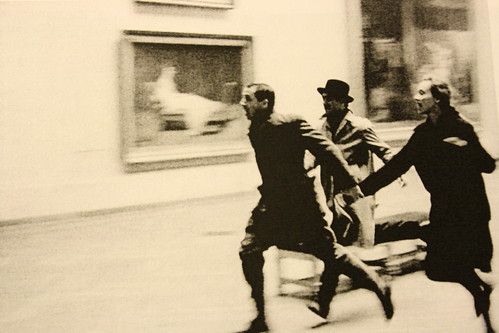
Still from Jean Luc Godard's Band of Outsiders. Included in publication for Media Lounge program. Februray 10, 2011. (Image Courtesy of Sabina Ott)
Previously I posted about the Media Lounge located at the Hilton on the Concourse Level. As part of an initiative to have more artist participation in the CAA Conference, Sabina Ott and Cindy Smith of the Services to Artists Committee worked back and forth between Chicago, New York and several other parts of the country to bring together nine artists and curators and create a video display to be seen by CAA attendees as well as the entire city of New York. To get more information about the project I sat down with one of the organizers, artist and educator Sabina Ott.
Tempestt Hazel: What is the Media Lounge?
Sabina Ott: The Media Lounge is a project put on by the Service to Artists Committee of the CAA. That was formed because the CAA felt that there wasn’t enough events and services for visual artists. It’s a group of people that aren’t necessarily on the board–there are a couple of board members, but it’s people from all over who have volunteered to be on the committee.
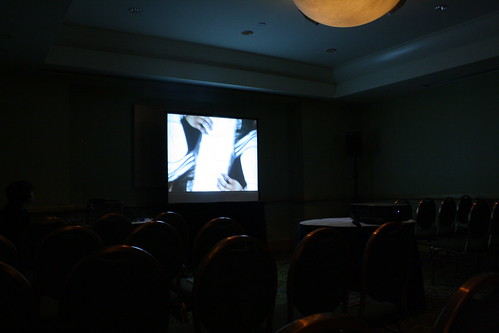
The Media Lounge at the Concourse Level of the Hilton. February 11, 2011. (Image Credit: Tempestt Hazel)
I volunteered to do the Media Lounge this year with Cindy Smith, and excellent New York based installation and video artist. And we decided to try and cover as much territory as possible and really expanded the program. We invited nine curators–and I say curators broadly. Some are curators, some are artists or designers who we asked to create one-hour video programs to their own discretion. They came up with incredible programs. Really beautifully designed, conceptually rigorous programs of video art.
TH: Where else will these videos be screened?
SO: We were offered the opportunity to screen our work at the Big Screen Project here in New York. It is an outdoor screen project where you basically sit at a bar across the street with headphones and watch the big screen video. You can also see it from the street but for sound you must be outside. The Big Screen Project edited the nine hours of work into a two hour program, taking at least one piece from each curator’s vision.
The Center For Book Arts is having a reception on Friday from 5-8pm for [Band of Outsiders]. Everyone should come. Alex Compos, the director of the Center for Book Arts also curated a program [for Band of Outsiders] and will be running the Media Lounge program for the entire month. So, people will be able to see all nine hours if they like.
TH: Where does the name of the program come from?
SO: This is called Band of Outsiders, which is based on a film by [Jean Luc] Godard. We felt that it really encapsulated the spirit of what we were really trying to accomplish and inviting people who are somewhat on the periphery of art production in some way or another.
It’s a brilliant program and brilliant curators! What I’m also very excited about is one of the curators I know, Debra Riley Parr, has curated a program based on design, which isn’t usually represented in these programs.

"Band of Outsiders", a book produced for the exhibition. February 10, 2011. (Image Credit: Tempestt Hazel)
Invited Curators:
Boshko Boskovic, Program Director at Residency Unlimited
Alexander Campos, Executive Director of the Center for Book Arts
David Familian, Artistic Director at Beall Center for Art and Technology
Claudia Hart, Associate Professor in the Department of Film, Video, New Media, and Animation at the School of the Art Institute of Chicago
Martha Kirszenbaum, Research Assistant at the New Museum
Karen Moss, Professor of Art History, Critical Theory Otis College of Art and Design and the University of Southern California’s Roski School of Fine Arts.
Aily Nash, Film Curator, Filmmaker and Writer
Debra Riley Parr, Associate Dean and Associate Professor of Art History at Columbia College Chicago
Catherine Sullivan, professor of art at the University of Chicago
Band of Outsiders will be on view at the Media Lounge in the CAA Conference now through Saturday, February 12th. The publication is available in limited numbers at the Media Lounge. If you want more information about this project and the Big Screen Project, click here.
Making a Living as an Artist (With or Without a Dealer) – part 1
Image Via
Today’s well attended ARTspace panel, “Making a Living as an Artist: With or Without a Dealer,” was lively and informative as all get-out. Organized and chaired by artist Sharon Louden, it brought to bear the expertise of a number of New York City’s finest art mavens: the artist and writer Sharon Butler, whose well appointed blog Two Coats of Paint will be familiar to many readers here; artist, former gallery director, curator and current Director of the Elizabeth Foundation for the Arts Studio Program Bill Carroll; artist, curator and current Dean of The New York Academy of Art Peter Drake; and New York dealer, inveterate blogger and author of How to Start and Run a Commercial Art Gallery Ed Winkleman.
[Full disclosure: I am represented by Winkleman Gallery; Sharon Butler, a fellow painter, is the author of one of my favorite art blogs, where she recently wrote a thoughtful review of my last show; Sharon Louden -- well, Sharon is every artist's hero (she's been mine for quite some time); and Bill Carroll and Peter Drake aren't exactly chopped liver! Basically, there was no way I was going to miss this panel...]
Here is an encapsulation of the discussion (paraphrased) — I’ve divided it up into several posts:
Sharon Louden: Everyone here on the panel wears a number of different hats; some of them have been through many dips in the economy before. My interest in gathering you together here is to explore how artists themselves have the power to weather these dips, and the kinds of partnerships that might help that process.
Bill Carroll: It is very difficult to make a living as an artist. You need a fallback, as it really is like a lottery. During a downturn, having a gallery may even be irrelevent if they can’t sell your work. Interestingly, more galleries closed during the 90s downturn than in this recent one. Back then, the mid-career artists were hit hardest — that market completely died. One of our artists [at Charles Cowles Gallery] who was a sculptor turned entirely to public commissions and it changed his career in a very positive way. He still makes sculpture, but public commissions have since become an important part of what he does.
Ed Winkleman: I have two collectors who’ve been collecting art for 35 years. When the downturn hit in 2008 they said: we just don’t know the real price of anything right now, and we’re going to hold off buying until we can determine which prices have been inflated. So, one thing artists can do in response to such a situation is to put out a new body of work with lower prices — if you are a painter, you might create a new series of drawings, for example — and get those out and into the market, rather than having to lower the prices of your existing body of work.
Sharon Butler: As an artist I want to remind people — I think many people forget — that artists have a lot of skills. In the last downturn, I decided to go to graduate school. I managed to get a scholarship and a stipend, and I treated it like a residency.
Peter Drake: If you’re in this room you are already proactive — artists and creative people taking control of their lives. I think of Jeffrey Lew and Gordon Matta-Clark and what they did when they established 112 Green Street.…
Image Via
Sharon L: Artists come to me and they ask: how do you get a dealer? But is having a dealer the answer? Is it key? Why is that perceived need there?
Sharon B: Having a dealer is only part of the puzzle of being an artist. Don’t put all your eggs in that basket. Even with gallery representation, you have to do things yourself. The reality is, THERE AREN’T ENOUGH GALLERIES to accommodate all the artists [and, it's intimated, not enough collectors - not enough demand].
Bill: You are ALWAYS responsible for your own career. A smaller gallery especially cannot be working on your career all the time. Most of the people I now who make a living off their work have several galleries — you need to look for galleries in other cities outside New York City.
Ed: There’s a sense you get, looking at submissions, that many artists think getting a gallery is an end-goal. Also, artists need to think in terms of working with a team — with their gallery. Especially during a downturn.
Bill: Many artists come into a gallery and think they’ve found parents (laughter).
Peter: There are many different “art worlds’… in any case it really is a partnership you enter into with your dealer. You have to adjust to make sure your partnership stays whole. You also have to help them extend their reach. To reciprocate, many dealers will ask their artists to curate shows.
To be continued… Part Two



